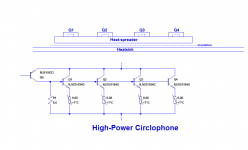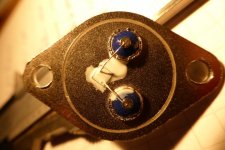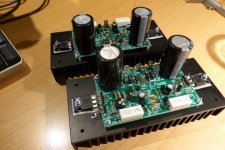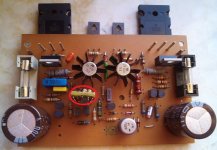I have examined the question, and I think I have found an acceptable solution: one that is safe and effective but also preserves the Circlophone sound character.So, question to Elvee - is it possible to make Circlophone BIGGER?
More power, more output transistors?
Not that it's rally needed, but what the heck..
Not everyone likes the sound of the C, but if someone builds a bigger version, he probably wants to keep all of its peculiarities, including the sound character.
It would of course be possible to just add largish emitter resistors for a safe paralleling, but the sound would be "anonymized", just like any other class AB amplifier.
The solution has three components:
-Matching of the paralleled transistors
-Use of special, PTC emitter resistors
-Mounting of the transistors on a common heat spreader to minimize inter-transistor Rth compared to the thermal resistance of each transistor to the ambience
These measures go against the Circlophone spirit of simplicity, absence of matching, tolerance and ease of mounting, which is why I shall develop them in a dedicated thread, because I do not want to confuse would-be builders and lead them into thinking that a 1kW C is going to be as easy as a 30W one.
In the meantime, here is a first preview of the method:
Attachments
Great! It looks like you're going to actually build it?These measures go against the Circlophone spirit of simplicity, absence of matching, tolerance and ease of mounting, which is why I shall develop them in a dedicated thread, because I do not want to confuse would-be builders and lead them into thinking that a 1kW C is going to be as easy as a 30W one.
It seems like beside mechanical issues (heatsinking), the only more complicated thing would be correct matching of the output devices.
Question - what will go wrong (beside the load being distributed not evenly between all devices) if they are not matched perfectly?
Not thinking about extreme cases when devices are totally unmatched,
but just slight differences?
Never tried paralleling BJTs. Only Mosfets, with mixed results.
Either it worked perfectly well (matched devices of course), or
I was getting oscillating amp, with no visible way to fix it.
Tried little zobel networks, different gate stoppers, different PCB designs, etc...
Same amp with one pair would work OK.
As for the spreader, and the insulation - looks like the best (expensive!) way, would be to use Keratherm sheet, or something similar..
Or maybe kapton tape (way cheaper, more fragile)?
Or maybe kapton tape (way cheaper, more fragile)?
Hi,
I saw this thread too late. At the moment I'm busy building a Velleman K8060, but I'm gonna build this Circlophone amplifier definitly, love this servo concept. I bought already all the semiconductors at a webstore with a "good" reputation (not ebay 😀) and tested the circuit with LTSpice. However there was a problem with the 2N3055's. On the invoice they were listed with a Country Of Origine indicated with n/a. That made me suspicious. I think these are fake types. After some searching on the internet I found out that ST doesn't make them anymore since 2013 and the datasheet on the website of ST tells me they are obsolete. Only ON makes them.
The print disappers with aceton and after opening the TO-3 housing there is a small die with tiny wires and a white compound. These little wires cannot handle 15 Amps. These devices are fuses. I have opened dozens of 2N3055 in my life but the die is to small for a 2n3055.
Ordered 4 new "ON Semiconductor" branded 2n3055 from Conrad. I hope they are genuine.
I saw this thread too late. At the moment I'm busy building a Velleman K8060, but I'm gonna build this Circlophone amplifier definitly, love this servo concept. I bought already all the semiconductors at a webstore with a "good" reputation (not ebay 😀) and tested the circuit with LTSpice. However there was a problem with the 2N3055's. On the invoice they were listed with a Country Of Origine indicated with n/a. That made me suspicious. I think these are fake types. After some searching on the internet I found out that ST doesn't make them anymore since 2013 and the datasheet on the website of ST tells me they are obsolete. Only ON makes them.
The print disappers with aceton and after opening the TO-3 housing there is a small die with tiny wires and a white compound. These little wires cannot handle 15 Amps. These devices are fuses. I have opened dozens of 2N3055 in my life but the die is to small for a 2n3055.
Ordered 4 new "ON Semiconductor" branded 2n3055 from Conrad. I hope they are genuine.
Attachments
Hi,
I think these are fake types. After some searching on the internet I found out that ST doesn't make them anymore since 2013 and the datasheet on the website of ST tells me they are obsolete. Only ON makes them.
Ordered 4 new "ON Semiconductor" branded 2n3055 from Conrad. I hope they are genuine.
Just use MJ21194 from reputable seller (like mouser)..
Put some plastic explosives inside and send them back !😡Hi,
I saw this thread too late. At the moment I'm busy building a Velleman K8060, but I'm gonna build this Circlophone amplifier definitly, love this servo concept. I bought already all the semiconductors at a webstore with a "good" reputation (not ebay 😀) and tested the circuit with LTSpice. However there was a problem with the 2N3055's. On the invoice they were listed with a Country Of Origine indicated with n/a. That made me suspicious. I think these are fake types. After some searching on the internet I found out that ST doesn't make them anymore since 2013 and the datasheet on the website of ST tells me they are obsolete. Only ON makes them.
The print disappers with aceton and after opening the TO-3 housing there is a small die with tiny wires and a white compound. These little wires cannot handle 15 Amps. These devices are fuses. I have opened dozens of 2N3055 in my life but the die is to small for a 2n3055.
Ordered 4 new "ON Semiconductor" branded 2n3055 from Conrad. I hope they are genuine.

I’ve really really really wanted to do that with a car stereo - after having head units stolen doing more damage to the vehicle than three head units cost. Get ready for a surprise!
The base of that package looks phony, and even with ST’s the tops don’t just pop off like that. The die isn’t THAT small for a 3055, and may in fact pass a 2N3055 spec - it is pretty loose. So loose in fact, that there is no reason to go out of your way to get them. No reason to get anything other than 21194 or 15024 if you’re buying them new. The 3055 was specified only because it is basically junk, and one of the big selling points of this amp design is that it works well even with “junk” output transistors. If you have something laying around that’s basically free, or can get some verifiable NOS for a buck, by all means use them. But paying six bucks for a 3055 from Mouser or wherever is stupid, because you can get something better for the same money.
The base of that package looks phony, and even with ST’s the tops don’t just pop off like that. The die isn’t THAT small for a 3055, and may in fact pass a 2N3055 spec - it is pretty loose. So loose in fact, that there is no reason to go out of your way to get them. No reason to get anything other than 21194 or 15024 if you’re buying them new. The 3055 was specified only because it is basically junk, and one of the big selling points of this amp design is that it works well even with “junk” output transistors. If you have something laying around that’s basically free, or can get some verifiable NOS for a buck, by all means use them. But paying six bucks for a 3055 from Mouser or wherever is stupid, because you can get something better for the same money.
Just use MJ21194 from reputable seller (like mouser)..
Yes, if the Conrad types are still not as they should be by the specs I buy them from Mouser or RS.
Put some plastic explosives inside and send them back !😡
Mmmmm, I first wait for the reaction of the firm. I made a complain. I think a text explosion on twitter with their name is more effective.
I’ve really really really wanted to do that with a car stereo - after having head units stolen doing more damage to the vehicle than three head units cost. Get ready for a surprise!
The base of that package looks phony, and even with ST’s the tops don’t just pop off like that. The die isn’t THAT small for a 3055, and may in fact pass a 2N3055 spec - it is pretty loose. So loose in fact, that there is no reason to go out of your way to get them. No reason to get anything other than 21194 or 15024 if you’re buying them new. The 3055 was specified only because it is basically junk, and one of the big selling points of this amp design is that it works well even with “junk” output transistors. If you have something laying around that’s basically free, or can get some verifiable NOS for a buck, by all means use them. But paying six bucks for a 3055 from Mouser or wherever is stupid, because you can get something better for the same money.
The base plate is to rough and the white stuff is in my opinion a strange additive. It is there to hide the die structure.
Junk! I do not know why some people here are negative about a 2N3055. This device is one of the best work horses in history. It is dated yes, but still it has its purpose. And about this amplifier concept. If junk goes in Junk goes out. This amplifier has specific capabilities to controle it's environment where a tranistor is embedded. This amplifier concept is remarkable. The only statement where I agree with is: "But paying six bucks for a 3055 from Mouser or wherever is stupid, because you can get something better for the same money"
My aim is to build the original Circlophone as stated in post #1. Even when there a "better" concept.
BTW I have discoverd that I had an offset of 300 mv in the sim when D11, D10 and C3 where omitted. After adding them the offset was 0.0000x.
The surface is rough, and the quality of the stamping is terrible. Burrs all over the place. The white goop isn’t there to hide the die - it’s there so it works at all. The dies they use for fakes have poor quality if any passivation layer. They’ll get moisture ingress and die very quickly without it. The can is obviously non hermetic - if it was you couldn’t get the lid off without ruining it.
The reason I say 3055s are junk is because hfe falls off to useless values above 7 amps or so, and is only supposed to be used under 60 volts. For what they cost today you can buy one that fits in the same socket and actually has a gain of more than 10 at 10 amps, and is legal to use at more than 60 volt rails. It may be all you need for an original Circlophone, but IMO not worth paying full price for. If I were building one, and not jazzing it up, I’d be using 2N5879’s - because I have 30 or 40 of them (that I didn’t pay full price for), or maybe a couple 2N5886 (also from the B-stock bin) if I was dead set on running 2 ohms with it.
The reason I say 3055s are junk is because hfe falls off to useless values above 7 amps or so, and is only supposed to be used under 60 volts. For what they cost today you can buy one that fits in the same socket and actually has a gain of more than 10 at 10 amps, and is legal to use at more than 60 volt rails. It may be all you need for an original Circlophone, but IMO not worth paying full price for. If I were building one, and not jazzing it up, I’d be using 2N5879’s - because I have 30 or 40 of them (that I didn’t pay full price for), or maybe a couple 2N5886 (also from the B-stock bin) if I was dead set on running 2 ohms with it.
I put one on a heatsink and tested it for current, didn't test it for voltage. I have a 5v 18A PSU from a computer. I connected a 4 ohm resistor to the base and an amp meter from +5v to the collector. Emitter to ground. I reached 9.8 ~ 10 A and the collector voltage dropped to 4V due to losses in the wiring. The device got pretty hot after 5 minutes.
Stressing the device over the 10 A it didn't survive, I used a much too low resitor value in the base line. My meter's limit is 10A, so I don't know what the actual blow-out value was.
wg_shi you are probably right that these 2n3055 could be used for the Circlophone albeit fakes.
Next week I get the ON Semiconductor types. Happy building to all.
Stressing the device over the 10 A it didn't survive, I used a much too low resitor value in the base line. My meter's limit is 10A, so I don't know what the actual blow-out value was.
wg_shi you are probably right that these 2n3055 could be used for the Circlophone albeit fakes.
Next week I get the ON Semiconductor types. Happy building to all.
Exactly, I couldn't have stated it better.No reason to get anything other than 21194 or 15024 if you’re buying them new. The 3055 was specified only because it is basically junk, and one of the big selling points of this amp design is that it works well even with “junk” output transistors. If you have something laying around that’s basically free, or can get some verifiable NOS for a buck, by all means use them. But paying six bucks for a 3055 from Mouser or wherever is stupid, because you can get something better for the same money.
Basically, any "big" NPN will do, and if its characteristics surpass the 3055 (which is not too difficult), you will have better performance than those advertised and measured with the initial circuit: some members have posted their measurement results, and they are better than mine.
Others followed the opposite route, and one even opted for transistor having a Ft of ~70kHz (I actually mean Ft, not Fh21e). No measurement results for that one, but the guy was satisfied, meaning the amplifier was listenable
Don't be too obsessed by the 3055: if you have anything big enough lying around, just use it: the ONsemi types are ideal, but almost anything else will also work: TIP35, BD245, BD249, etcThe only statement where I agree with is: "But paying six bucks for a 3055 from Mouser or wherever is stupid, because you can get something better for the same money"
My aim is to build the original Circlophone as stated in post #1. Even when there a "better" concept.
Probably a sim artifact: there is no good reason for it.BTW I have discoverd that I had an offset of 300 mv in the sim when D11, D10 and C3 where omitted. After adding them the offset was 0.0000x.
With completely random, unmatched input transistors, the offset should remain below 15mV.
In practice, members have reported much lower values, because modern transistors have a tight process control
I have now launched the high-power Circlophone thread:
High-Power Circlophone
Not to be confused with the regular C: operating at these power levels mandates good construction techniques, especially regarding the thermal aspects, matching will become necessary, and you have to build yourself some of the critical components.
Definitely not a project for beginners.....
High-Power Circlophone
Not to be confused with the regular C: operating at these power levels mandates good construction techniques, especially regarding the thermal aspects, matching will become necessary, and you have to build yourself some of the critical components.
Definitely not a project for beginners.....
My own design PCB
Hi all,
This is the PCB files of my current "vanilla" Circlophone that I posted its photos at #1436 . I draw it for myself using Inkscape vector drawing program so no CAD files and no regular BOM either. I just picked this for my daily usage because I like its layout and I especially intended to make it look a retro design.
Hi all,
This is the PCB files of my current "vanilla" Circlophone that I posted its photos at #1436 . I draw it for myself using Inkscape vector drawing program so no CAD files and no regular BOM either. I just picked this for my daily usage because I like its layout and I especially intended to make it look a retro design.
Attachments
Elvee,
Question - is it doable to replace LTP input in circlophone with opamp?
Would this improve things?
All the opamp-input amps I was recently siming and/or building seem to have much better characteristics and low THd.
Question - is it doable to replace LTP input in circlophone with opamp?
Would this improve things?
All the opamp-input amps I was recently siming and/or building seem to have much better characteristics and low THd.
The inherent linearity and high loop gain of a good opamp do indeed allow very low THD figures, but I do not see how to reconcile this with the C principle, which is a "vertical" (or common-mode if you like) modulation of the whole amplification chain to control the bias current and the transition region of mainly the OP stage.
The control signal is injected as the tail current of the input LTP.
Maybe with an OTA or a programmable opamp, but to my knowledge, the existing types in these categories aren't famed for their spectacular audio performance.
Interesting idea anyway, I'll think about it.
Improving the linearity and gain of the LTP is possible: by replacing it with a cross-quad, or even better with an "Eva-quad", but these beasts aren't forgiving, and I couldn't include them in the C, which is supposed to always work, no matter what you throw into it
The control signal is injected as the tail current of the input LTP.
Maybe with an OTA or a programmable opamp, but to my knowledge, the existing types in these categories aren't famed for their spectacular audio performance.
Interesting idea anyway, I'll think about it.
Improving the linearity and gain of the LTP is possible: by replacing it with a cross-quad, or even better with an "Eva-quad", but these beasts aren't forgiving, and I couldn't include them in the C, which is supposed to always work, no matter what you throw into it
Last edited:
- Home
- Amplifiers
- Solid State
- ♫♪ My little cheap Circlophone© ♫♪




